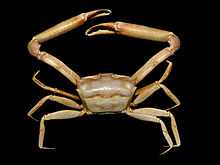Goneplax rhomboides
| Goneplax rhomboides | |
|---|---|
 | |
| Scientific classification | |
| Kingdom: | Animalia |
| Phylum: | Arthropoda |
| Subphylum: | Crustacea |
| Class: | Malacostraca |
| Order: | Decapoda |
| Infraorder: | Brachyura |
| Family: | Goneplacidae |
| Genus: | Goneplax |
| Species: | G. rhomboides |
| Binomial name | |
| Goneplax rhomboides (Linnaeus, 1758) | |
Goneplax rhomboides is a species of crab. It is known by the common name angular crab[1] because of its angular carapace.[2] Although it is also called the square crab,[3] its shell is in fact more trapezoidal than square (or rhomboidal, as its scientific name might suggest).[2] This species is also known as the mud-runner because they are able to run away quickly when threatened.[2]
Description
Goneplax rhomboides is a relatively small, distinctive-looking crab that ranges from yellowish-white, to orange, to reddish, to vivid pink in colour.[1][3][4] It has a smooth, quadrangular, strongly convex carapace that is much broader than it is long. It has long, slender pereiopods with margins of propodus and dactylus bristles.[5] It likewise has setae on its antennae and mouthparts.
Females have short chelipeds but the chelipeds of males are long, with the merus portion of the claw considerably longer than the length of their carapaces.[5] G. rhomboides has often been confused with G. clevai, a similar species sharing at least part of its range.[6] Its eyes are on the end of long, retractable eyestalks.[2]
Distribution and habitat
G. rhomboides is found in the northeastern Atlantic Ocean and the Mediterranean Sea from the North Sea to southern Africa and the Indian Ocean coast of South Africa.[6] Waters off Shetland constitute the northern boundary of its range, and in 2008, marine biologists from the University of Gothenburg discovered one intact in the stomach of a cod caught off the coast of Bohuslän which suggests that G. rhomboides has now moved into Swedish waters. A similar discovery a few weeks later in the same location reinforces this conclusion.[1]
This species inhabits muddy habitats similar to those favoured by the Norway lobster[7] and burrows into inshore muddy sand.[8] Its burrows often interconnect in complex patterns with those inhabited by other species of burrowing megafauna such as Callianassa subterranea, Cepola macrophthalma, Lesueurigobius friesii, and Nephrops norvegicus. These multi-species burrow complexes are very common in some localities.[9]
Symbiosis
The setae on the antennae, mouthparts and legs of G. rhomboides are home to Triticella flava, a species of Bryozoa ("moss animal").[9] The short lifespan of these symbiotic moss animals is synchronized so that they produce larvae just before G. rhomboides moults. These larvae then attach to the crab's newly-emerged exoskeleton.[2]
References
| External identifiers for Goneplax rhomboides | |
|---|---|
| Encyclopedia of Life | 1040133 |
| ITIS | 98917 |
| WoRMS | 107292 |
| Also found in: MarLIN, GBIF | |
| Wikimedia Commons has media related to Goneplax rhomboides. |
- ↑ 1.0 1.1 1.2 Krister Svahn (June 4, 2008). "New crab found in Swedish waters". University of Gothenburg.
- ↑ 2.0 2.1 2.2 2.3 2.4 Sue Scott (January 16, 2007). "British Beasts - mud-runner". Dive Magazine.
- ↑ 3.0 3.1 Chris Proctor (1993). "A mass stranding in Torbay". British Marine Life Study Society.
- ↑ "Angular crab (Goneplax rhomboides)". The Field Studies Council. Retrieved January 27, 2010.
- ↑ 5.0 5.1 M. J. de Kluijver & S. S. Ingalsuo (2008). "Goneplax rhomboides". Macrobenthos of the North Sea: Crustacea. Universiteit van Amsterdam. Retrieved January 23, 2009.
- ↑ 6.0 6.1 Danièle Guinot & Peter Castro (2007). "A new species of Goneplax Leach, 1814 (Crustacea, Decapoda, Brachyura, Goneplacidae) from the south Atlantic and the western limits of the Indo-West Pacific region, long confused with G. rhomboides (Linnaeus, 1758)". Zootaxa 1577: 17–31.
- ↑ Rosanna Milligan (January 14, 2009). "Angular crab - Goneplax rhomboides". Wild Ocean Photography: Wildlife and Coastal Images of Scotland.
- ↑ "Sea Pens and Burrowing Megafauna". U.K. Marine Special Areas of Conservation. Retrieved January 27, 2010.
- ↑ 9.0 9.1 "Community ecology: interactions between species".